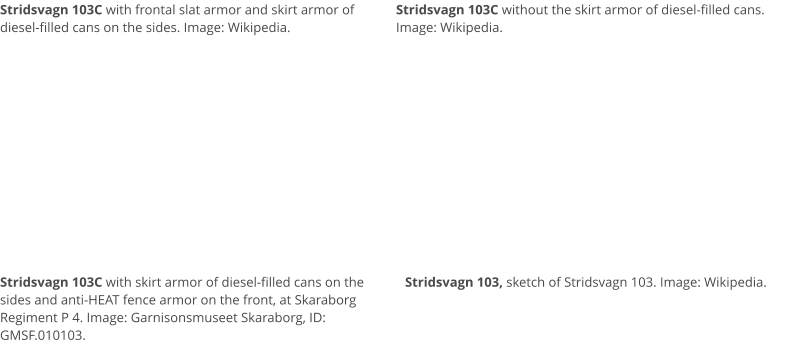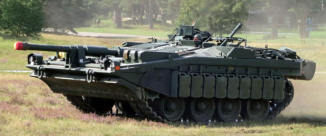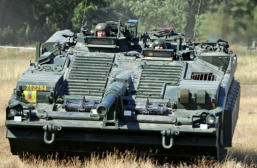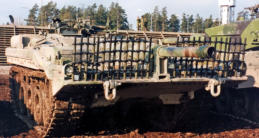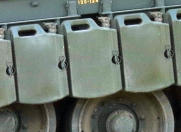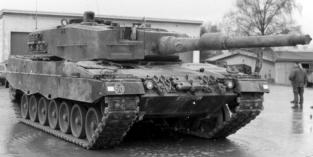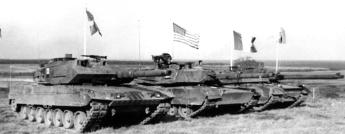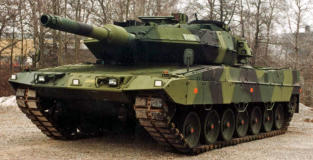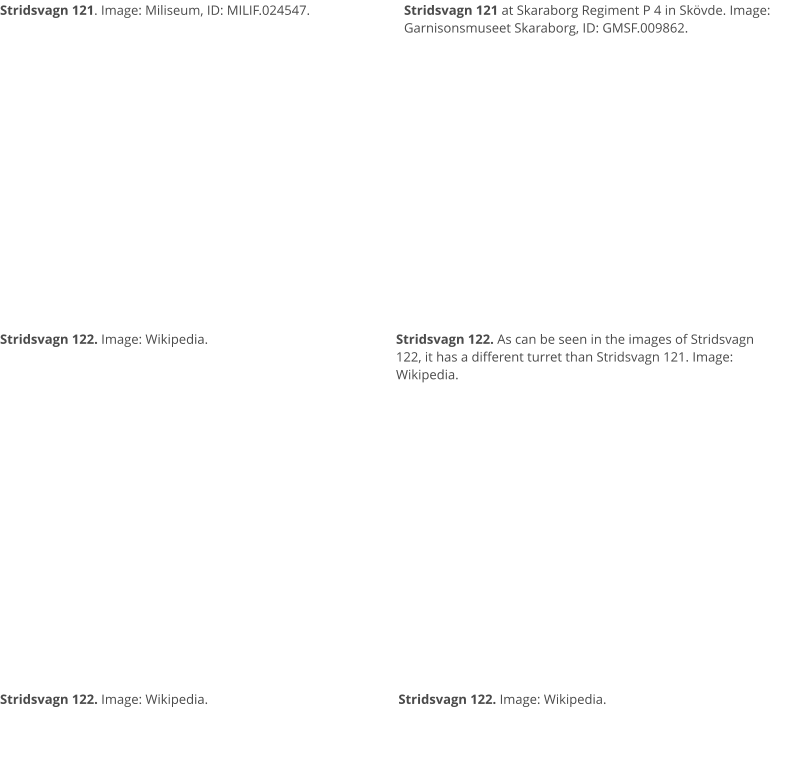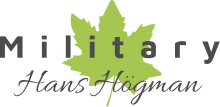

Copyright © Hans Högman 2022-08-03


Swedish Tanks
List of Tanks in the Swedish Army
The names of the Swedish tanks begin with
"Stridsvagn" (tank) followed by its designation.
•
Renault FT, 1 in Swedish service 1922 – 1926
•
Stridsvagn m/1921, 10 in Swedish service 1922
– 1934
•
Stridsvagn m/1921-29, 5 in Swedish service
1930 – 1939 (converted Stridsvagn m/21)
•
Stridsvagn fm/1928, 1 in Swedish service 1926
- 1936
•
Tankette m/Carden-Loyd (Mk V), 1 in Swedish
service 1931- 1939
•
Tankette m/Carden-Loyd (Mk VI), 1 in Swedish
service 1931 – 1939
•
Stridsvagn m/1931, 3 in Swedish service 1935-
1940
•
Stridsvagn fm/1931, 1 in Swedish service 1935
– 1940
•
Stridsvagn m/1937, 48 in Swedish service 1937
- 1953
•
Stridsvagn m/1938 (L-60), 16 in Swedish service
1938 – 1957
•
Stridsvagn m/1939 (L-60), 20 in Swedish service
1941 - 1957
•
Stridsvagn m/1940L (L-60), 100 in Swedish
service 1941 - 1957
•
Stridsvagn m/1940K (L-60), 80 in Swedish
service 1944 - 1960
•
Stridsvagn m/1941, 116 + 104 in Swedish
service 1942 – 1960?
•
Stridsvagn m/1942, 282 in Swedish service
1943 - 1955
•
Stridsvagn 74, 225 in Swedish service 1958 –
1984 (converted Strv m/1942)
•
Stridsvagn 81, 240 (80 + 160) in Swedish
service 1953 – 1966
•
Stridsvagn 101, 102 and 104; in Swedish
service 1959 - 2000
•
Stridsvagn 103, 290 in Swedish service 1967 –
2001
•
Stridsvagn 121 and 122 plus 123
Tanks of Sweden - 4
The mass indicated on the tanks is in metric tons.
"Strv" is the Swedish military abbreviation of
Stridsvagn.
To the List of Tanks in the Swedish Army
Related Links
•
Tanks - Home page
•
Tanks, page-2
•
Tanks, page-4
•
Combat Vehicles, page-1
•
Uniforms of the Armored Troops
•
Unit designation listing of the Swedish armored
troops
•
Uniforms of the Swedish Army, 1900s
•
Sweden’s Military Preparedness 1939 - 1945
•
Military Images, Sweden, 1939 - 1945
•
Swedish Military Aircraft
Source References
1.
Svensk PansarHistorisk Förening
2.
Pansar by Rickard O. Lindström
3.
Arsenalen, militärt fordonsmuseum,
Arsenalen is a Tank Museum in Strängnäs,
Sweden
4.
Armémuseum, Army Museum, Stockholm
5.
Wikipedia
6.
Digitaltmuseum (Digital Museum)
Top of page
Stridsvagn 103
Stridsvagn 103 is a Swedish main battle tank
manufactured in Sweden by Bofors and designed by
Sven Berge. It has become commonly known as
"Stridsvagn S". Stridsvagn 103 has a unique design
with a turretless chassis. The gun is fixed, mounted
in the chassis, and points straight ahead. Pointing the
gun is done by maneuvering the whole vehicle. The
Stridsvagn 103 option was adopted in the 1958
Defence Act.
It was developed in the late 1950s and early 1960s
and delivered to the Swedish Army between 1967
and 1971. Between 1967 and 1971, 290 units of
Stridsvagn 103 were delivered.
Together with the Centurion tanks, Stridsvagn 103
formed the main part of the Swedish army's armored
troops until the 1990s, when they were replaced by
Stridsvagn 121 and Stridsvagn 122.
Stridsvagn 103 was withdrawn from the defense
organization in 1997. A total of 302 vehicles were
produced, including
experimental models.
The image shows
Stridsvagn 103C. Image:
Wikipedia.
The concept was a medium tank with a low silhouette
that showed less target area. This was achieved by
mounting the gun in the hull instead of in a turret.
The fixed gun is traversed by engaging the tracks and
elevated by adjusting the hull suspension.
As the gun was fixed in the chassis, the whole vehicle
had to be turned by utilizing track movements to aim
the gun sideways, and the whole tank had to be
raised and lowered using hydraulics to aim the gun
vertically, which gave the gun the correct angle of
elevation.
The two images show a Stridsvagn 103C that
demonstrates gun elevation and depression using
suspension.
The upper of the two
smaller images show a
Stridsvagn 103C with the
gun pointing downwards,
i.e. stooping. The lower
picture shows a Stridsvagn
103C with the gun pointing
upwards, i.e. reclining.
Image: Wikipedia.
The lack of turrets gave the tank a low and flat profile,
making it harder to hit and more resistant to enemy
fire. Good optics and the stable mounting of the gun
also made it possible to fire quickly and at long
distances with precision. The disadvantage was that
it was impossible to aim the gun for shots while
traveling, except straight ahead in the direction of
travel. This was considered an acceptable
disadvantage, as contemporary tanks with movable
turrets could aim their cannon while traveling, but
with such low accuracy that even they were normally
forced to stop before firing.
Another unique detail was that one of the three
crewmen was seated facing backward and had his
own steering gear so that he could drive the tank
away from the enemy at high speed without having
to expose the thinner side and rear armor.
The fact that the gun was mounted inside the chassis
made it difficult to upgrade the tank to a more
powerful caliber gun when this later became an
option.
Stridsvagn 103 had a three-man crew: a
commander, a gunner/driver, and a rear driver. The
main armament consisted of a Bofors 10.5 cm rifled
automatic gun with L/62 caliber. The gun was
designed to fire the same ammunition used by
Stridsvagn 101 and 102 tanks. The gun in Stridsvagn
103 was fully automatic with an integrated automatic
loader, which classifies it as an automatic gun.
Alongside the main armament were three 7.62 mm
machine guns of the type Ksp 58 strv. One of the
three Ksp 58s was mounted on the commander's
observation hatch. In addition to the main gun and
machine guns, Stridsvagn 103 was also equipped
with smoke launchers. Both the commander and
the driver could drive and shoot with the tank.
During the REMO (Renovation and Modification)
for Stridsvagn 103C, the tank was also equipped with
Lyran 71 mm illuminating mortars.
The front consisted of a 40 mm thick armored shield.
The roof was also 40 mm thick. The sides were only
20 mm thick but were reinforced with internal fuel
cans placed along the sides to function as applique
armor for extra protection against directed blast. The
front was also equipped with 30 mm high, 40 mm
deep slat armor that increased frontal protection.
Slat armor takes the form of a rigid slatted metal grid
fitted around key sections of the vehicle which
disrupts the shaped
charge of the warhead.
The image shows a
Stridsvagn 103C with
frontal slat armor for
protection against high-
explosive anti-tank
(HEAT) attacks. Image:
Wikipedia.
At mobilization, the tank was also equipped with the
secret anti-HEAT fence armor, Additive equipment
2930, which consisted of 30 mm diameter steel rods
to be mounted on the front edge of the frontal armor
for the protection against high-explosive Anti-tank
(HEAT) rounds. The anti-HEAT fence armor disrupts
the shaped charge of the warhead by either crushing
it, preventing optimal detonation from occurring, or
by damaging the fuzing mechanism, preventing
detonation outright. This made Stridsvagn 103 the
best frontally protected tank in the world for more
than 20 years.
The image to the left
shows a Stridsvagn 103
with anti-HEAT fence
armor on the front
effective against HEAT
rounds (HEAT = High-
explosive Anti-Tank). Image : Garnisonsmuseet
Skaraborg, ID: GMSF.012598.
For the C variant, also diesel-filled
cans of skirt armor on the sides of
the tank provided additional
protection against HEAT rounds. See
the image to the right.
Two engines were used in
Stridsvagn 103, a diesel engine from Rolls Royce and a
gas turbine from Boeing.
Stridsvagn 103 also had an amphibious capability.
This was possible thanks to the erection of floating
bellows around the tank. Propulsion was achieved by
using the tracks at a speed of 6 knots.
International interest:
When Stridsvagn 103 was unveiled at a press
preview in the spring of 1963, it caused an
international sensation around the world. Interest
in the Stridsvagn 103 was very high. A dense stream
of visitors from some 10 countries came to Sweden
to learn more about the unique design, including
France, Britain, Germany, and the United States. On
four occasions, the tank was tested in other
countries: Norway, England, Germany, and the USA.
Ten Stridsvagn 103s were in the British Army of the
Rhine (BAOR) in Germany for 35 days in 1973 for
testing and they rolled 900 km each. The Stridsvagn
103 was compared to the British Chieftain tank. It
turned out that the Stridsvagn 103 had significantly
higher reliability than the Chieftain tank. The final
report stated, "It has not been possible to prove any
disadvantage in the 103s inability to fire on the move."
Two tanks were loaned to the United States in 1975
for seven months for testing at Fort Knox. During the
tests, Stridsvagn 103 was compared with the
American M 60 tank. Over 188 days, the two Swedish
tanks drove 1400 km and fired a total of 575 rounds.
The trials in the USA met the positive expectations
that the Americans had had of the Stridsvagn 103.
The tests showed that the Stridsvagn 103 fired more
accurately, but that on average it took half a second
longer to get a shot off.
But of course, there has been criticism too. It has
received harsh criticism, mainly from older Swedish
conservative officers of the armored troops who have
wanted to describe Stridsvagn 103 as a fiasco. They
felt that a real tank should have a turret, which
Stridsvagn 103 lacked. The most serious criticism of
Stridsvagn 103, however, was that it could not fire on
the move. Of course, there were contemporary tanks
that could fire on the move, but the accuracy was so
low that usually only a first shot was fired on the
move, and then the fight continued from a stationary
tank. So that limitation was not a major problem at
that time.
Variants of Stridsvagn 103:
•
Stridsvagn 103-0:
In 1960, before Stridsvagn 103 was ordered for
mass production, 10 pre-production tanks called
Stridsvagn 103-0 were ordered. They were
delivered in 1963 and were largely similar to tank
103A but lacked slat armor. These tanks were to
be used to test the Stridsvagn 103 in the field but
formally saw service. The trials lasted until 1966.
•
Stridsvagn 103A:
The first variant of the 103, with a 300-hp gas
turbine engine, was ordered in 1964. 70 tanks
were produced and serial deliveries began in
1967.
•
Stridsvagn 103B:
The B-variant had a more powerful 490 hp gas
turbine engine, fitted flotation equipment, and
removed IR headlights. 220 tanks were produced
and delivered between 1970-1971.
In parallel, the A-variant of 70 tanks was modified
to B standard. All 290 Stridsvagn 103Bs were
delivered by 1971.
•
Stridsvagn 103C:
The Defense Act of 1978 and 1982 meant that the
acquisition of a new tank had to wait until the
1990s, after which modification of the existing
tanks became necessary. The refurbishment and
modification of all 290 Stridsvagn 103Bs included
improvements to the following such as a laser
range-finder integrated with the gunner's sight, a
new piston engine from Detroit Diesel, a partially
new gearbox, an option for skirt armor consisting
of diesel-filled jeep cans and illuminating mortars.
All 290 rebuilt 103Bs entered service in 1986-1988
under the designation Stridsvagn103C.
•
Stridsvagn 103D:
The D-variant was a prototype for further
development of the 103C if the army was not to
be supplied with a new tank (Strv Ny).
Stridsvagn 103 was decommissioned from the
Swedish war organization in 2001.
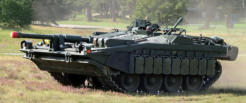


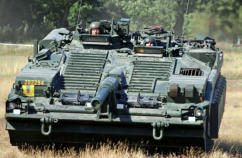
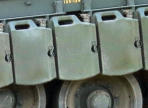
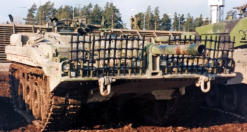
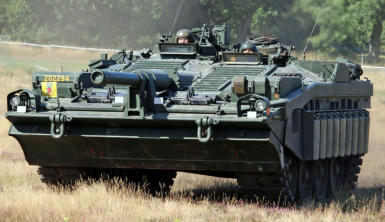
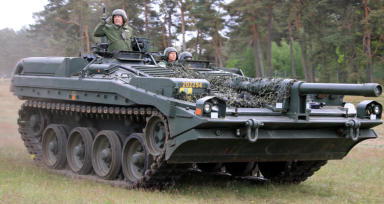
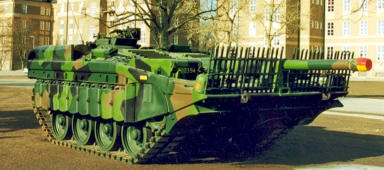
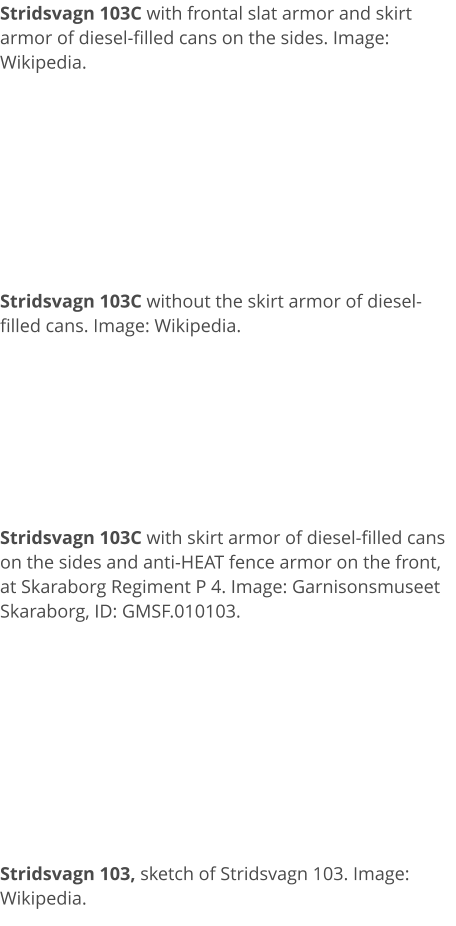
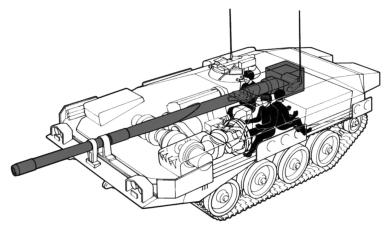
Specifications Strv 103A:
•
Crew
3
•
In Swedish service
1967 – 1971
•
Mass
37.7 ton
•
Main armament
1 x 10.5 cm gun L/62
•
Sec- armament
3 x 7.62 mm machine gun 58
strv
•
Length
7.60 m (9.00 m incl. gun barrel)
•
Width
3.32 m
•
Height
2.14 m
•
Armor
40 mm + anti-HEAT fence
armor
•
Max. speed
50 km/h
•
Engines
Rolls-Royce K60 (240 hp) + Boeing
GT502 (300 hp)
•
Fuel
Diesel
•
Numbers, Sweden
70
•
Converted
70 units to Stridsvagn 103B,
1970 – 1971.
Specifications Strv 103B:
•
Crew
3
•
In Swedish service
1970 - 1988
•
Mass
39.7 ton
•
Main armament
1 x 10.5 cm gun L/62
•
Sec- armament
3 x 7.62 mm machine gun 58
strv
•
Length
7.60 m (9.00 m incl. gun barrel)
•
Width
3.42 m
•
Height
2.14 m
•
Armor
40 mm + anti-HEAT fence
armor
•
Max. speed
50 km/h
•
Engines
Rolls-Royce K60 (240 hp) +
Caterpillar 553 (490 hp)
•
Fuel
Diesel
•
Numbers, Sweden
220
•
Converted
220 + 70 units to Stridsvagn
103C,
1986 – 1988.
Specifications Strv 103C (converted Strv 103B):
•
Crew
3
•
In Swedish service
1986 - 2001
•
Mass
39.7 ton
•
Main armament
1 x 10.5 cm gun L/62
•
Sec- armament
3 x 7.62 mm machine gun 58
strv
•
Length
7.60 m (9.00 m incl. gun barrel)
•
Width
3.42 m (3.63 m with the diesel
cans)
•
Height
2.14 m
•
Armor
40 mm + anti-HEAT fence
armor
•
Max. speed
55 km/h
•
Engines
Detroit Diesel 6V-53T (240 hp) +
Caterpillar 553 (490 hp)
•
Fuel
Diesel
•
Numbers, Sweden
290
Images
Stridsvagn 121 and 122
Towards the end of the 1980s and the beginning of
the 1990s, the Swedish Defense Material
Administration (FMV) had been conducting trials with
modern tanks. The results showed that Sweden
urgently needed a new tank. The projected
development of the new Stridsvagn 2000 was no
longer deemed sustainable, so in the spring of 1991,
the government proposed purchases from abroad,
which were confirmed in the 1992 Defense Act.
The procurement of the "Stridsvagn Ny" (project
name: Tank New) started in September 1991 and was
the largest procurement of a foreign weapon system
carried out by the Swedish Defense Material
Administration, FMV.
Stridsvagn Ny meant that FMV borrowed the most
modern Western main battle tanks of the time for
testing to see which tank was most suitable for the
Swedish armed forces. The final report with the given
quotations was completed in December 1993.
The German Leopard 2 won this test in competition
with the French Leclerc and the American M1 Abrams.
The image shows the three tanks that were evaluated.
Lined up from left, the German Leopard 2 A5, the
American M1A2 Abrams, and the French Leclerc.
Image: Garnisonsmuseet Skaraborg, ID:
GMSF.025509.
On 20 January 1994, the Swedish government decided
to acquire 120 Leopard 2 S with an option for 90
additional tanks. The procurement involved large
parts of the Swedish arms industry for further
development and licensed production.
Stridsvagn 121:
At the same time as the negotiations on the Leopard
2 A5 S tank were taking place, Sweden was offered an
extremely favorable leasing contract for 160 of the
older Leopard 2 A4s, which was signed on 12 August
1994, as a stopgap before the newer tanks were
finished.
Delivery began the same month and these tanks
became the first tanks in Sweden with a 12 cm gun
and were designated Stridsvagn 121. By the end of
1994, all 160 tanks had been delivered.
The Defense Act of 2000 removed Stridsvagn 121
from the peace and war organization in 2002. After
the Defense Act of 2004, all Stridsvagn 121 were
placed in storage and since 2002 the army has only
used Stridsvagn 122.
The image shows a
Stridsvagn 121 at
Skaraborg Regiment P 4
in Skövde. Image:
Garnisonsmuseet
Skaraborg, ID:
GMSF.009862.
Stridsvagn 122:
Stridsvagn 122 (product name Leopard 2 Improved A5
SE or Leopard 2 S for short) is a main battle tank
developed by the German company Krauss-Maffei
and the Swedish company Åkers Krutbruk Protection
AB on behalf of the Swedish Defense Material
Administration (FMV) for the Swedish Armed Forces.
The tank is a further developed version of the
German Leopard 2 A5 main battle tank with
significantly improved ballistic protection. The Leopard
2 S tank has been produced both in Germany and in
Sweden under license for Swedish use.
Stridsvagn 122 entered service in 1996 and has been
the Swedish Army's primary main battle tank since its
final delivery in 2002. Stridsvagn 122 replaced the
older tanks Stridsvagn 101, 102, 103, and 104 and
after some time also Stridsvagn 121.
The first 29 new Leopard tanks were assembled in
Germany. The remaining 91 tanks were built under
license in Sweden. Bofors was responsible for the
turret and Hägglunds for the chassis and final
integration.
In total, 120 Stridsvagn 122 was ordered by the
Swedish defense.
The image shows a
Stridsvagn 122 (Leopard
2 S). Image:
Garnisonsmuseet
Skaraborg, ID:
GMSF.021545.
The first Stridsvagn 122 was delivered to FMV in
December 1996 for type testing and was then, being
the second tank with a 12-centimeter gun,
designated Stridsvagn 122. The last of the ordered
120 Stridsvagn 122 was delivered to the Swedish
Armed Forces in 2002.
Stridsvagn 122 has a 4-man crew, a tank commander,
a driver, a gunner, and a loader.
Basically, the Leopard 2 is a conventionally designed
tank with the front part of the hull divided: the driver
on the right, ammunition storage on the left, and in
the center-mounted turret the tank commander is on
the right, the gunner sits lower and in front of the
commander and the loader on the left side. The
engine package is located at the rear of the hull. The
main armament consists of a smooth-bore gyro-
stabilized 12 cm high-pressure gun, which allows
very high accuracy while moving. The secondary
armament consists of two 7,62 mm m/94 machine
guns.
Variants:
•
Stridsvagn 121A:
Stridsvagn 121A was originally designated simply as
Stridsvagn 121 and was the 160 Leopard 2 A4
tanks from Germany that Sweden leased in 1994 to
immediately reinforce Sweden's armored forces
pending the final delivery of Stridsvagn 122.
142 of these have been returned to Germany while
18 chassis have been purchased for training or
conversion to other types of vehicles.
•
Stridsvagn 121B:
Stridsvagn 121B was an attempt to update
Stridsvagn 121A to a standard equivalent to
Stridsvagn 122. One (1) prototype was built and
tested between November 2003 and April 2004.
•
------------------------
•
Stridsvagn 122A:
Stridsvagn 122A is the original version that Sweden
ordered from Germany, i.e. 120 Leopard 2 A5, of
which 29 were produced in Germany and the rest
on license in Sweden. The first delivery took place
in December 1996. The main individual
modifications to Stridsvagn 122 compared to
Stridsvagn 121 are the significantly improved
ballistic protection and the added TCCS (Tank
Command & Control System). Externally, the
differences between Stridsvagn and Stridsvagn 121
are mainly visible on the turret.
•
Stridsvagn 122B:
Stridsvagn 122B is a REMO version of Stridsvagn
122A (REMO = renovation and modification). Among
other things, it is equipped with additional reduced
and modular AMAP composite armor, which
provides increased all-around protection against
shaped charges, HEAT grenades, and improvised
explosive devices (IED).
10 were delivered in 2002. 10 Stridsvagn 122B and
4 Stridsvagn 122A are being converted to
Stridsvagn 122B INT in 2011 (INT = International).
•
Stridsvagn 122C:
Stridsvagn 122A undergoing a minor REMO, to
replace the lead batteries and build up a spare
parts stock for at least three years' consumption. In
addition, the tank commander’s gun sight has been
upgraded, and new internal and radio
communication systems have been installed.
Finally, they will be prepared to fit the same
additional protection used on the 122B. The
delivery took place in 2016.
•
Stridsvagn 122D:
Stridsvagn 122B which has undergone a minor
REMO in the same way as Stridsvagn 122C above.
90 Stridsvagn 122 underwent RENO following a
decision taken in 2016. In addition to the renovation,
the vehicles will also be equipped with a battalion-
level battle management system (SLB) and a new
communications system (KOMNOD and TGR). This
means a lifetime extension until 2030. This RENO will
result in new designations. Stridsvagn 122A is
renamed Stridsvagn 122C and Stridsvagn 122B is
renamed Stridsvagn 122D.
The Swedish Leopard 2 family includes not only the
battle tank but also the armored recovery vehicle (Bgbv
120), the armored engineering vehicle (Ingbv 120), and
the armored bridge-laying vehicle (Brobv 120).

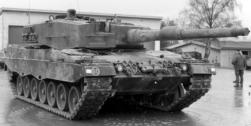
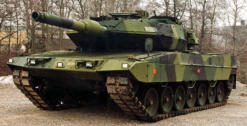
Specifications Strv 121A:
•
Crew
4
•
In Swedish service
1994 – 2006
•
Mass
55.2 ton
•
Main armament
1 x smooth-bore 120 mm
Rheinmetall L/44
•
Sec- armament
1 x coax machine gun 94 +
1 x machine gun 94 at the loaders
hatch
•
Smoke launchers
8 x 2 Wegmann smoke
launchers
•
Length
7.93 m (9.67 m incl. gun barrel)
•
Width
3.75 m
•
Height
2.79 m
•
Max. speed
68 km/h
•
Engine
MTU 12 cylinder MB 873-Ka
501,
with twin exhaust turbo, 1.500
hp
•
Fuel
Diesel
•
Numbers, Sweden
160
Specifications Strv 122A:
•
Crew
4
•
In Swedish service
1997 –
•
Mass
62.5 ton
•
Main armament
1 x smooth-bore 120 mm
Rheinmetall L/44
•
Sec- armament
1 x coax machine gun 94 +
1 x machine gun 94 at the loaders
hatch
•
Smoke launchers
4 x 2 st GALLIX smoke
launchers
from GIAT
•
Length
7.93 m (9.74 m incl. gun barrel)
•
Width
3.80 m
•
Height
2.99 m
•
Max. speed
72 km/h
•
Engine
MTU 12 cylinder MB 873-Ka
501,
with twin exhaust turbo, 1.500
hp
•
Fuel
Diesel
•
Numbers, Sweden
120 (14 of these have been
converted to Stridsvagn 122B)
Specifications Strv 122B (converted Strv 122A):
•
Crew
4
•
In Swedish service
2002 –
•
Mass
65.2 ton
•
Main armament
1 x smooth-bore 120 mm
Rheinmetall L/44
•
Sec- armament
1 x coax machine gun 94 +
1 x machine gun 94 at the loaders
hatch
•
Smoke launchers
4 x 2 st GALLIX smoke
launchers
from GIAT
•
Length
7.93 m (9.74 m incl. gun barrel)
•
Bredd
3.80 m
•
Height
2.99 m
•
Max. speed
72 km/h
•
Engine
MTU 12 cylinder MB 873-Ka
501,
with twin exhaust turbo, 1.500
hp
•
Fuel
Diesel
•
Numbers, Sweden
14
Images
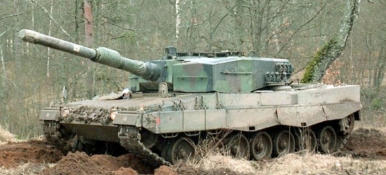
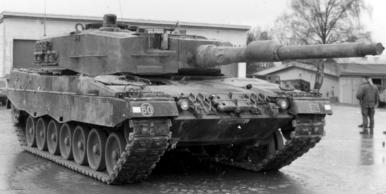
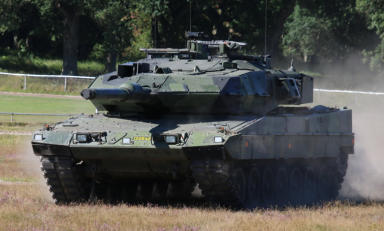
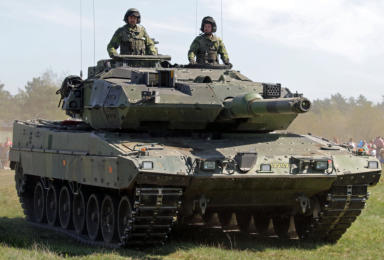
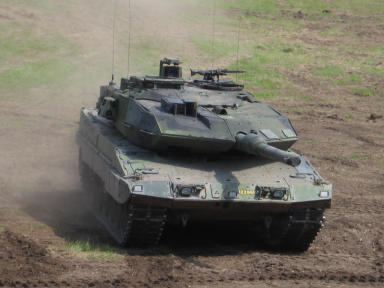

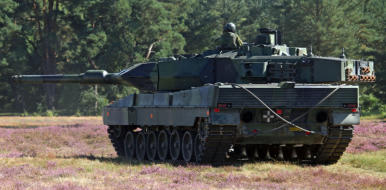
Stridsvagn 123
In January 2025, the Swedish Armed Forces ordered
44 new Leopard 2 A8 main battle tanks and
decided to upgrade the 110 existing Stridsvagn 122
[Leopard 2 A5], (44 already in 2023 + 66 now) and the
Combat Vehicle 90 fleet. 10 of the new tanks will
replace the tanks previously donated by Sweden to
Ukraine.
The new Leopard 2 A8 tanks will be designated
Stridsvagn 123B in Sweden.
The existing Stridsvagn 122 tanks, which are now
being upgraded, will be designated Stridsvagn
123A.
Sweden will thus have 154 modern tanks.
The upgrades to the existing Stridsvagn 122s include
new guns, improved protection and increased
digitalization. The upgraded Stridsvagn 122s are
planned to be delivered to the Armed Forces
between 2027 and 2030, while the newly
manufactured Leopard 2 A8s will be delivered
between 2028 and 2031.







